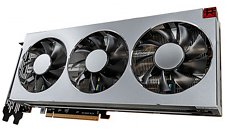Friday, February 8th 2019

No AMD Radeon "Navi" Before October: Report
AMD "Navi" is the company's next-generation graphics architecture succeeding "Vega" and will leverage the 7 nm silicon fabrication process. It was originally slated to launch mid-2019, with probable unveiling on the sidelines of Computex (early-June). Cowcotland reports that AMD has delayed its plans to launch "Navi" all the way to October (Q4-2019). The delay probably has something to do with AMD's 7 nm foundry allocation for the year.
AMD is now fully reliant on TSMC to execute its 7 nm product roadmap, which includes its entire 2nd generation EPYC and 3rd generation Ryzen processors based on the "Zen 2" architecture, and to a smaller extent, GPUs based on its 2nd generation "Vega" architecture, such as the recently launched Radeon VII. We expect the first "Navi" discrete GPU to be a lean, fast-moving product that succeeds "Polaris 30." In addition to 7 nm, it could incorporate faster SIMD units, higher clock-speeds, and a relatively cost-effective memory solution, such as GDDR6.
Source:
Cowcotland
AMD is now fully reliant on TSMC to execute its 7 nm product roadmap, which includes its entire 2nd generation EPYC and 3rd generation Ryzen processors based on the "Zen 2" architecture, and to a smaller extent, GPUs based on its 2nd generation "Vega" architecture, such as the recently launched Radeon VII. We expect the first "Navi" discrete GPU to be a lean, fast-moving product that succeeds "Polaris 30." In addition to 7 nm, it could incorporate faster SIMD units, higher clock-speeds, and a relatively cost-effective memory solution, such as GDDR6.

135 Comments on No AMD Radeon "Navi" Before October: Report
Remember Navi was meant to be a mainstream gaming platform, not high-end.
And another question one could ask: how interesting it this? Not much.
On the graph you've shown "Navi 12" performs like a Vega 64, while "Navi 10" would be a Radeon VII. "Navi 8" could be a polished 7nm GCN, but it's also now far from successful Radeon VII overclocks.
Performance is not a problem. AMD has that.
What would actually be interesting is these 3 bars being not FPS but peak Watts.
Nvidia's bars are actually pretty close to TPU results...
200W is more or less the limit Sony is going to accept for "big" PS5 (PS5 Pro?).
Assuming they'll dump optical drive, PS5 could be half the size of PS4 Pro. I'm sure they'll go this route - users are complaining about size of current consoles.
ASRock DeskMini GTX is 2.7l (compared to PS4's 5.3l) and can come with a GTX 1080.
Polaris 21 = RX 560
AMD tends to start with the biggest chip first so, yeah, the numbering makes sense in that context (lower number = bigger chip = more power).
I don't put much faith in the Navi # they provide though.
Navi gonna let you down
Navi gonna run around and desert you
Navi gonna make you cry
Navi gonna say goodbye
Navi gonna tell a lie and hurt you
www.cowcotland.com/news/66004/radeon-vii-une-carte-graphique-pour-patienter-jusqu-a-octobre-pour-l-architecture-navi.html